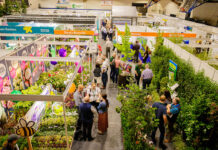Bank economist Pavan Sukhdev, has a different take on biodiversity than Dana. It is much more than ‘snowdrops and daffodils’ and ‘all kinds of everything’. According to Sukhdev who led a working group on establishing a fairly precise idea on nature’s economic value, nature filters water, regulates climate and gives jobs, for example, in tourism. 11% of the Earth’s surface which is given over to nature conservation is calculated to give benefits worth five trillion dollars a year. That is more than the global turnover of three major industries – automotive, information technology and steel – added together.
Snowdrops and daffodils are beginning to flower in my garden but not all species in Europe are faring so well. Last November, the European Environment Agency reported that 53% of EU flora and fauna species were not in a healthy place. Extinction is not new, but in recent times we are witnessing extinction of species at between 100 and 1000 times the historic background rate.
My friend John Gormley TD, as Environment Minister in 2008 published an important report called the Economic and Social Aspects of Biodiversity. Essentially, non-human life benefits the Irish economy to the value of atleast €2.6 billion per annum. According to Dr. Craig Bullock, one of the authors, the earthworm alone is worth between €700 – €1000 million and likewise bees add €53 million in value to Irish food and agriculture. The value of bees to the wider environment, woodlands, tourism etc, is about €500 million.
I had the honour of opening a beautiful Biodiversity Exhibition in Malahide Library on Saturday, 14th January 2011. The talents of the Camera Club and Tidy Towns Association came together to mark the culmination of 2010 the UN International Year of Biodiversity. The UN requires Ireland to play an effective role in turning the tide of biodiversity and habitat loss. John Gormley took his responsibilities to the UN seriously, but got little thanks from those who are ignorant of what is at stake. Biodiversity, which has taken four billion years to develop, gives us food, fibre, fuel, building material, clean water and fresh air, as well as an appreciation of beauty. Locally we share this island with 12,000 insect species, 2,000 of which are beetles. A teaspoon of garden soil could have another billion types of bacteria. As the song goes, ‘All God’s creatures got a place in the choir’.
As an organic gardener, the more species in my garden in general, the better the balance between predator and prey, the faster green waste breaks down and the less pests and disease epidemics I suffer. Essentially a biodiverse garden is a healthy garden.
The severe weather over Christmas has killed off the more tender plants. When replacing these, I am minded to think ‘biodiversity’. If I need trees in a small garden, I’ll consider Alder for a damp patch, as finches like the catkins. Rowan or Common Whitebeam will give berries to starlings, thrushes, fieldfares, etc. Finches also like Birch. Chiffchaff and tits like the insects found on Willow. Coaltits and Goldcrest like Larch.
Some shrubs also produce berries for birds and others, such as Berberis, Holly, Viburnum and Common Buckthorn, Cotoneaster, Honeysuckle and Ivy. Pyracantha has red berries but it useful in other ways too. It will grow near a north facing wall and attracts nest building birds when fully grown as the thorns will deter predators, whether four or two-legged.
The biodiversity debate extends beyond wildlife, flora and fauna. The diversity of apple, potato or any number of vegetable and fruit species is now a shadow of the former range of species grown. 90% of the agricultural biodiversity in the EU has been lost. Those of us fortunate to have a kitchen garden or allotment have a chance to help turn this tide. This is but one aspect of an economic aswell as an ecological recovery which will benefit this and future generations.







